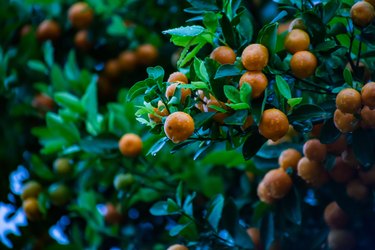
Citrus trees require warm, almost sub-tropical climates to flourish, so it should come as no surprise that America's largest citrus-producing states lie in the southern latitudes. Major citrus producers like Florida, California and Arizona have a blend of fertile soil and year-round warm temperatures that help cultivate a healthy citrus crop each year.
Citrus Fruit From Florida
Video of the Day
The Florida citrus industry is the largest in the country. Citrus plants first arrived in the state when Spanish explorers like Ponce De Leon planted citrus trees on Florida's east coast in the mid-1500s, and commercial farmers began growing the trees for profit around the middle of the 19th century. Today, Florida boasts more than 74 million citrus trees spread over more than 569,000 acres of official citrus groves, according to the state's citrus website.
Video of the Day
Growers in the state most commonly grow grapefruit and oranges, but some also produce limes and Temple oranges. In addition, specialty fruits like tangelos grow only in the Sunshine State. Each year, Florida's citrus fruit crop and byproducts like the famed Florida Orange Juice bring in more than $9 billion, and almost 76,000 Florida residents work in some aspect of the industry, as of 2010.
California, Number Two Producer
Second only to Florida, the massive California citrus industry churns out more than 3.2 million tons of fruit in an average year. California produces mostly oranges and lemons, as the two fruits combined represent more than 90 percent of California citrus fruit production. The remaining 9 percent of citrus crop consists of grapefruits, tangerines and clementines. About three quarters of California's oranges are of the sweet navel variety, and most of those oranges arrive in the store for sale as fresh fruit, rather than in a processed product like orange juice or concentrate.
Although the value of California's citrus crop pales in comparison to Florida's numbers, the state still earns a respectable $578 million from an average year's crop, as of 2010. California produces most -- about 87 percent according to the USDA -- of the lemons shipped to American states, and an active shipping industry allows citrus farmers to meet to a growing international demand.
Arizona Citrus Fruit Production
Like Florida and California, Arizona enjoys a warm climate well suited for citrus fruit growth. The USDA's center for Integrated Pest Management, commonly known as the IPM, notes that Arizona produces the second most lemons in the United States and fills 18 percent of American demand. Orange and grapefruit production ranks fourth -- behind Florida, California and Texas -- and Arizona produces about 13 percent of America's tangerines. A typical annual crop of Arizona citrus commands a value of between $39.2 and $92.8 million, as of 2010.
The state's climate, which features northern areas that endure cold winters and occasional water shortages, contributes to the low citrus output, as production remains largely limited to the southern counties of Yuma, Maricopa, Mohave and Pinal.
Texas: Major Citrus State In Crisis
Ice storm Uri blasted through (week of Feb. 13-17, 2021), freezing much of the Great State of Texas with temperatures as low as 19 degrees F. Upwards of 60 percent of the state's citrus crops were destroyed. Prior to that storm, Texas occupied third place in the country's citrus production, behind Florida and California. Damages to citrus crops and trees is estimated at more than $300 million, a large chunk of the $600 million total Texas agricultural losses.
Growers project that they'll be marketing only about 30 percent of their citrus crops for the 2021-2022 season. Because most of the fruit comes in from September through May, little to no citrus production is expected until the following growing season.
Some growers are replanting trees. However, most others may have to wait as long as three years before they can buy new trees to plant. This is due to a shortage – most nurseries authorized to sell citrus trees in Texas are low on availability, forcing most citrus growers to start from scratch.